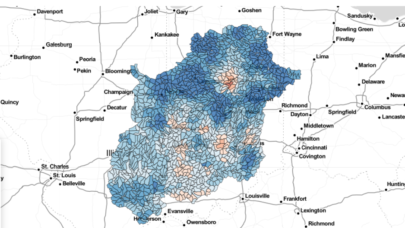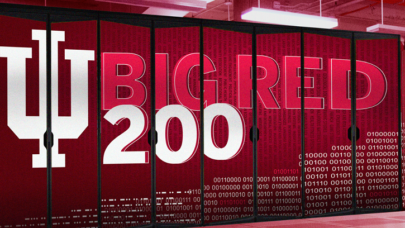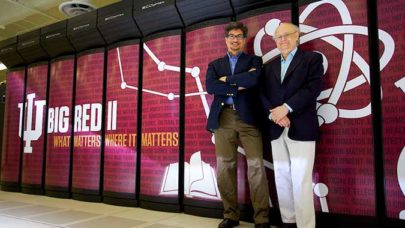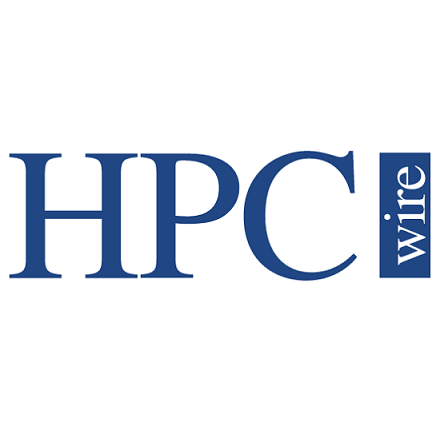
Closing ISC Keynote by Sterling and Suarez Looks Backward and Forward
May 25, 2023
ISC’s closing keynote this year was given jointly by a pair of distinguished HPC leaders, Thomas Sterling of Indiana University and Estela Suarez of Jülich S Read more…

Indiana University to Deploy Jetstream 2 Cloud with AMD, Nvidia Technology
June 2, 2020
Indiana University has been awarded a $10 million NSF grant to build ‘Jetstream 2,’ a cloud computing system that will provide 8 aggregate petaflops of comp Read more…

Indiana University Researchers Use Supercomputing to Model the State’s Largest Watershed
February 20, 2020
With water stressors on the rise, understanding and protecting water supplies is more important than ever. Now, a team of researchers from Indiana University ha Read more…

Indiana University Dedicates ‘Big Red 200’ Cray Shasta Supercomputer
January 24, 2020
After six months of celebrations, Indiana University (IU) officially marked its bicentennial on Monday – and it saved the best for last, inaugurating Big Red Read more…

Thomas Sterling on CREST and Academia’s Role in HPC Research
February 27, 2017
The US advances in high performance computing over many decades have been a product of the combined engagement of research centers in industry, government labs, Read more…

Jetstream, the NSF-funded “Science” Cloud, Launches Tomorrow
August 31, 2016
Jetstream, the expansive NSF-funded cyberinfrastructure project intended in large measure to serve the long tail of science will officially launch tomorrow (9/1 Read more…

Jetstream: Targeting the Long Tail of Science
May 21, 2015
Improving HPC access to the so-called long tail of science is an ongoing NSF priority. Several initiatives, funded at least in part by NSF, are underway and one Read more…

NCGAS Makes HPC a Mainstay Tool for Biologists
August 22, 2013
The National Center for Genome Analysis Support (NCGAS) at Indiana University has expanded its services to help biologists use high-performance computing, NCGAS’ manager announced at a July 23 presentation at the XSEDE13 conference in San Diego. Read more…

- Click Here for More Headlines

Whitepaper
Transforming Industrial and Automotive Manufacturing
In this era, expansion in digital infrastructure capacity is inevitable. Parallel to this, climate change consciousness is also rising, making sustainability a mandatory part of the organization’s functioning. As computing workloads such as AI and HPC continue to surge, so does the energy consumption, posing environmental woes. IT departments within organizations have a crucial role in combating this challenge. They can significantly drive sustainable practices by influencing newer technologies and process adoption that aid in mitigating the effects of climate change.
While buying more sustainable IT solutions is an option, partnering with IT solutions providers, such and Lenovo and Intel, who are committed to sustainability and aiding customers in executing sustainability strategies is likely to be more impactful.
Learn how Lenovo and Intel, through their partnership, are strongly positioned to address this need with their innovations driving energy efficiency and environmental stewardship.
Download Now
Sponsored by Lenovo
Whitepaper
How Direct Liquid Cooling Improves Data Center Energy Efficiency
Data centers are experiencing increasing power consumption, space constraints and cooling demands due to the unprecedented computing power required by today’s chips and servers. HVAC cooling systems consume approximately 40% of a data center’s electricity. These systems traditionally use air conditioning, air handling and fans to cool the data center facility and IT equipment, ultimately resulting in high energy consumption and high carbon emissions. Data centers are moving to direct liquid cooled (DLC) systems to improve cooling efficiency thus lowering their PUE, operating expenses (OPEX) and carbon footprint.
This paper describes how CoolIT Systems (CoolIT) meets the need for improved energy efficiency in data centers and includes case studies that show how CoolIT’s DLC solutions improve energy efficiency, increase rack density, lower OPEX, and enable sustainability programs. CoolIT is the global market and innovation leader in scalable DLC solutions for the world’s most demanding computing environments. CoolIT’s end-to-end solutions meet the rising demand in cooling and the rising demand for energy efficiency.
Download Now
Sponsored by CoolIT
Advanced Scale Career Development & Workforce Enhancement Center
Featured Advanced Scale Jobs:
HPCwire Resource Library
HPCwire Product Showcase
© 2024 HPCwire. All Rights Reserved. A Tabor Communications Publication
HPCwire is a registered trademark of Tabor Communications, Inc. Use of this site is governed by our Terms of Use and Privacy Policy.
Reproduction in whole or in part in any form or medium without express written permission of Tabor Communications, Inc. is prohibited.
























